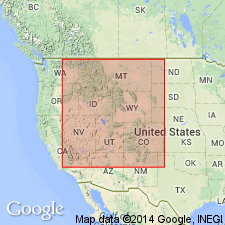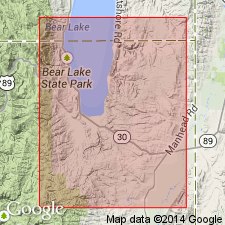
- Usage in publication:
-
- Wasatch limestone*
- Modifications:
-
- Original reference
- Dominant lithology:
-
- Limestone
- AAPG geologic province:
-
- Wasatch uplift
Summary:
Pg. 477-479. Wasatch limestone. Carboniferous and Devonian limestones, consisting of: (1) 4,000 feet of limestone carrying Coal-measure fossils; (2) 1,000 to 1,200 feet of sub-Carbonifeorus limestones underlain by beds containing fossils that have close resemblance to Waverly group but which are considered by Hall and Whitfield as closely allied to Upper Devonian; (3) lower 1,200 to 1,400 feet characterized by Devonian (Upper Helderberg and Chemung) fossils and a single group of fossils that seem to have the facies of both Upper and Lower Helderberg. Total thickness in Wasatch Mountains, Utah 7,000 feet; in middle Nevada over 8,000 feet.
[Recognized in northern Wasatch Mountains, northeastern UT.]
Source: US geologic names lexicon (USGS Bull. 896, 2278-2279).

- Usage in publication:
-
- Wasatch limestone†
- Modifications:
-
- Abandoned
- AAPG geologic province:
-
- Wasatch uplift
Summary:
Pg. 407. Divided the Wasatch limestone of King in north part of Wasatch Mountains into (descending): Brazer limestone (Upper Mississippian), 800 to 1,400 feet; Madison limestone (Lower Mississippian), 600 to 1,600 feet; Threeforks [Three Forks] limestone (Upper Devonian), 200 feet; Jefferson dolomite (Middle Devonian), 1,200 feet; Laketown dolomite (Silurian), 1,000 feet; and Fish Haven dolomite (Upper Ordovician), 500 feet. The Fish Haven dolomite rests on Swan Peak quartzite (Lower Ordovician), evidently mistaken by King for the Cambrian quartzite in Ogden Canyon.
Source: US geologic names lexicon (USGS Bull. 896, 2278-2279).
For more information, please contact Nancy Stamm, Geologic Names Committee Secretary.
Asterisk (*) indicates published by U.S. Geological Survey authors.
"No current usage" (†) implies that a name has been abandoned or has fallen into disuse. Former usage and, if known, replacement name given in parentheses ( ).
Slash (/) indicates name conflicts with nomenclatural guidelines (CSN, 1933; ACSN, 1961, 1970; NACSN, 1983, 2005, 2021). May be explained within brackets ([ ]).

